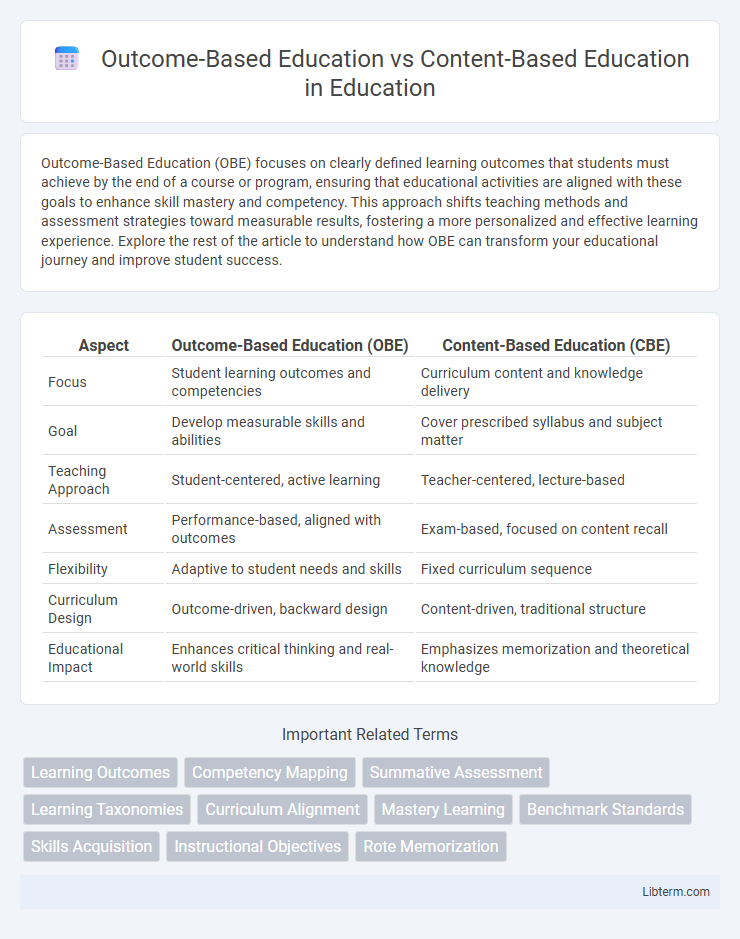Outcome-Based Education (OBE) focuses on clearly defined learning outcomes that students must achieve by the end of a course or program, ensuring that educational activities are aligned with these goals to enhance skill mastery and competency. This approach shifts teaching methods and assessment strategies toward measurable results, fostering a more personalized and effective learning experience. Explore the rest of the article to understand how OBE can transform your educational journey and improve student success.
Table of Comparison
| Aspect | Outcome-Based Education (OBE) | Content-Based Education (CBE) |
|---|---|---|
| Focus | Student learning outcomes and competencies | Curriculum content and knowledge delivery |
| Goal | Develop measurable skills and abilities | Cover prescribed syllabus and subject matter |
| Teaching Approach | Student-centered, active learning | Teacher-centered, lecture-based |
| Assessment | Performance-based, aligned with outcomes | Exam-based, focused on content recall |
| Flexibility | Adaptive to student needs and skills | Fixed curriculum sequence |
| Curriculum Design | Outcome-driven, backward design | Content-driven, traditional structure |
| Educational Impact | Enhances critical thinking and real-world skills | Emphasizes memorization and theoretical knowledge |
Introduction to Educational Approaches
Outcome-Based Education (OBE) emphasizes measuring student performance through clearly defined learning outcomes and competencies, ensuring that education aligns with practical skills and real-world application. Content-Based Education focuses primarily on delivering a structured curriculum centered around subject matter, prioritizing the amount and depth of content coverage. Both approaches influence instructional design and assessment methods, shaping how educators plan lessons and evaluate student progress.
Defining Outcome-Based Education
Outcome-Based Education (OBE) centers on clearly defined learning outcomes that specify what students should know, understand, and be able to do after completing a course or program. This educational approach emphasizes measurable results and accountability, aligning curriculum, teaching methods, and assessments with predetermined competencies and skills. OBE shifts the focus from content delivery to achieving specific, demonstrable learner achievements, fostering practical application and mastery of knowledge.
Understanding Content-Based Education
Content-Based Education centers on delivering structured subject matter with an emphasis on comprehensive coverage and in-depth knowledge acquisition. It prioritizes curriculum design that allocates specific time frames to topics, aiming for mastery of factual content and theoretical frameworks. This approach ensures students develop a solid foundation of discipline-specific information before applying skills in practical contexts.
Core Principles of Each Approach
Outcome-Based Education (OBE) centers on defining specific learning outcomes that students must achieve, emphasizing mastery of skills and competencies through continuous assessment. Content-Based Education focuses on delivering a structured curriculum with a fixed body of knowledge, prioritizing coverage of subject matter over measurable student achievements. OBE promotes learner-centered approaches and adaptability, while Content-Based Education values standardized content delivery and traditional teaching methodologies.
Curriculum Design Differences
Outcome-Based Education (OBE) prioritizes designing curricula around specific, measurable competencies and real-world skills students must demonstrate upon course completion. Content-Based Education (CBE) centers on traditional subject matter and knowledge delivery, emphasizing depth of topics rather than practical application or performance outcomes. OBE curricula feature flexible sequencing and assessments aligned to desired results, whereas CBE follows a fixed syllabus with standardized evaluation focused on content retention.
Assessment and Evaluation Methods
Outcome-Based Education (OBE) emphasizes assessment methods that measure students' mastery of specific skills and competencies through performance-based tasks, portfolios, and real-world problem-solving activities. In contrast, Content-Based Education relies heavily on traditional evaluation techniques such as standardized tests, multiple-choice exams, and rote memorization to assess knowledge retention of subject matter. OBE's continuous and formative assessments provide detailed feedback on learning progress, while Content-Based Education focuses on summative evaluations to rank and grade students based on content absorption.
Student Learning Experience
Outcome-Based Education (OBE) emphasizes mastering specific skills and competencies, resulting in a tailored learning experience that adapts to individual student progress and real-world applicability. Content-Based Education (CBE), centered on delivering predefined subject matter, often leads to a more uniform but less personalized learning path. OBE enhances active engagement and critical thinking by focusing on measurable outcomes, while CBE prioritizes knowledge acquisition through standardized curricula.
Teacher Roles and Responsibilities
In Outcome-Based Education (OBE), teachers act as facilitators guiding students toward achieving specific learning outcomes, continuously assessing progress and adapting instruction accordingly. Content-Based Education (CBE) positions teachers as primary knowledge transmitters, emphasizing the delivery of predefined content with less flexibility in assessment methods. OBE demands increased teacher accountability in designing learner-centered activities and personalized feedback, whereas CBE focuses on maintaining curriculum coverage and content accuracy.
Pros and Cons Comparison
Outcome-Based Education (OBE) emphasizes measurable skills and competencies, promoting personalized learning paths and clearer assessment criteria, but may limit creativity and focus too narrowly on specific outcomes. Content-Based Education (CBE) prioritizes comprehensive knowledge acquisition and foundational understanding, supporting broad subject expertise but often lacks flexibility and can lead to rote memorization. Both approaches present trade-offs between skill application and content mastery, influencing curriculum design and student engagement differently.
Choosing the Best Approach for Learners
Outcome-Based Education (OBE) centers on mastering specific skills and competencies, ensuring learners achieve measurable results aligned with real-world demands, while Content-Based Education (CBE) emphasizes delivering comprehensive subject matter knowledge. Selecting the best approach depends on learner goals, with OBE offering flexibility and practicality for skill acquisition and CBE providing depth in foundational understanding. Educational institutions benefit from integrating both strategies to tailor instruction that meets diverse learner needs and promotes effective knowledge application.
Outcome-Based Education Infographic

 libterm.com
libterm.com